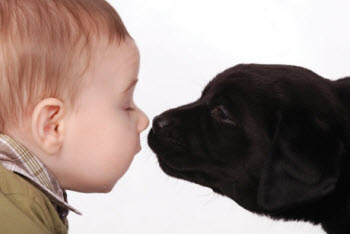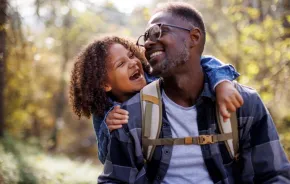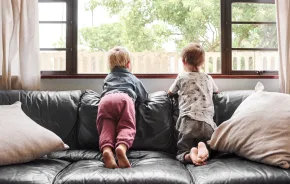 I remember the moment we decided our dog would never hurt our baby. Our firstborn had just learned to crawl. We watched with pride as she exerted her newfound independence, moving across the living room away from us. Then suddenly, she turned and crawled straight over to our dog and, without pausing, took the bone out of his mouth with her own mouth.
I remember the moment we decided our dog would never hurt our baby. Our firstborn had just learned to crawl. We watched with pride as she exerted her newfound independence, moving across the living room away from us. Then suddenly, she turned and crawled straight over to our dog and, without pausing, took the bone out of his mouth with her own mouth.
When we — still across the room ― realized what was happening, we froze. The dog simply opened his jaw and allowed her to take his prize without a fight. Our sighs were audible. “Wow, now we know he’ll never hurt her,” we said, laughing with relief. Since then, our trust in our four-legged family member has never waned.
But reading about the Las Vegas family whose trusted dog suddenly attacked and killed their 1-year-old when the baby went to give the dog a good-night hug, made me pause. “I never thought that dog would do anything to my baby,” The Las Vegas Journal-Review quoted the father as saying. “Always be careful, even if you trust your dog. I trusted my dog, and now I don’t have a baby or a dog.”
In fact, bites and injuries from pets can happen. According to the Centers for Disease Control and Prevention, 800,000 Americans seek medical attention for dog bites each year, and half of these are children. While the highest rate of dog bites occurs with kids ages 5 to 9, the majority of bites in children ages 4 and younger are to the head or neck. And, according to Dr. Tony Woodward, chief of emergency medicine at Seattle Children’s Hospital, bites to that region are often the most serious.
“Always err on the side of caution,” says Brie Fox, owner of Brie Fox Dog Training in Bothell, and mother of two. “Dogs and young children should always be directly supervised.”
Fox recommends that parents plan ahead, even before the baby is born, by establishing a contained place where the dog can relax when you can’t be supervising. “You want to set the kids and dogs up to like each other.” She suggests crate training, a process that trains the dog to stay in a cage when you need to have him separated. “It’s a fabulous tool for creating a hands-free place where the dog can go and the kid won’t be able to poke. A lot of people are hesitant to crate train, but your dog will thank you. …And baby gates are not just for kids.”
Patty Lindley, mother of two and managing editor of ParentMap, understands why it’s important to keep dogs and kids safe. “My daughter had wanted a dog for years and had been negotiating up since she got a hermit crab,” she says. When her kids were 10 and 6, she and her husband relented and got a terrier.
Lindley says she and her husband knew their terrier, which is a breed known to be cute yet aggressive, would take some extra work. But her husband had grown up with a terrier and liked these dogs. The couple thought they were up to the challenge. This spring, however, Lindley’s dog bit her 6-year-old son on the lip.
“Hypervigilance is just not part of our household,” says Lindley. “However, it took a bad thing to show us what we already knew.” Dog owners, she notes, should understand their pet’s breed and unique characteristics. Because Lindley and her husband know terriers get very excited, for example, they no longer allow their dog in the same room as the family when they are eating.
Watch for warning signs
Biting is an animal’s “final warning sign,” says Fox. “It’s the pet’s way to control its environment — or make whatever is bothering them go away.” Look for warning signs that your dog is uncomfortable, she says. Be especially alert if your dog licks his lips and nose slowly; yawns; shows the whites of his eyes; or growls.
“Never punish your dog for growling, because you want your kid to be growled at rather than bitten,” she warns. “When I hear a growl, I say ‘thank you very much’ and remove the kid.”
And remember: Dogs are not people. “They don’t like to be hugged. They like attention in a different way,” she says. “Most dogs are great and put up with a lot. But biting often occurs when people grab the collar or try to control the dog’s neck.”
Woodward says emergency room doctors see an array of dog bite injuries, ranging from cosmetic injuries to death. Most of the critical injuries happen when babies are left alone with dogs. “It takes one bite to the head to have a serious or fatal injury,” he says. “It is key for parents to never leave infants or toddlers alone with dogs — all it takes is one moment.”
And it’s not all about dogs. Pet owners know to keep close tabs on kitty. “I think the cat was just overwhelmed by the noise and by having both kids on the bed with him,” says Diane Thompson, whose cat bit her infant. “The baby was pulling on him, and the cat just turned quickly, bit him on the arm and ran.”
The cat didn’t break the skin, but Thompson, a Kirkland mom, is not taking any chances. “Now we really watch them when they’re together,” she says. “I’ll always keep my hand on the cat’s head — and we work more with the baby to make sure he’s not pulling.”
When to get help
What should parents do if their child gets scratched or bitten?
According to Woodward, if it’s just a scratch (that’s when it’s not bleeding and you can’t pull the wound open), and you know the animal has been vaccinated, wash the wound at home and keep your eye on it for signs of infection. If there’s bleeding, have a physician take a look. And be sure to see a doctor if an unknown animal bit your child and you’re not certain it’s been vaccinated.
With a bite to the head, always go to the emergency room, says Woodward. “Sometimes you can’t tell how serious a head bite is. There could be internal bleeding or crushed bones that could cause serious injury.”
The bottom line? When it comes to small children and pets, be vigilant and be smart. As the experts advise, even the friendliest of pets might scratch or bite if it feels threatened, afraid or hurt.
Jennifer Armstrong lives in Kirkland, with her husband, two young daughters and rescued beagle. She is a freelance writer and planning coach at mission-forward.com.
Resources
For more information about setting up your family for success with your dog, contact a dog trainer, such as Brie Fox. Fox also recommends the following books:
Living with Kids and Dogs . . . Without Losing Your Mind, by Colleen Pelar
Calming Signals, by Turid Rugaas
The Other End of the Leash, by Patricia McConnell









